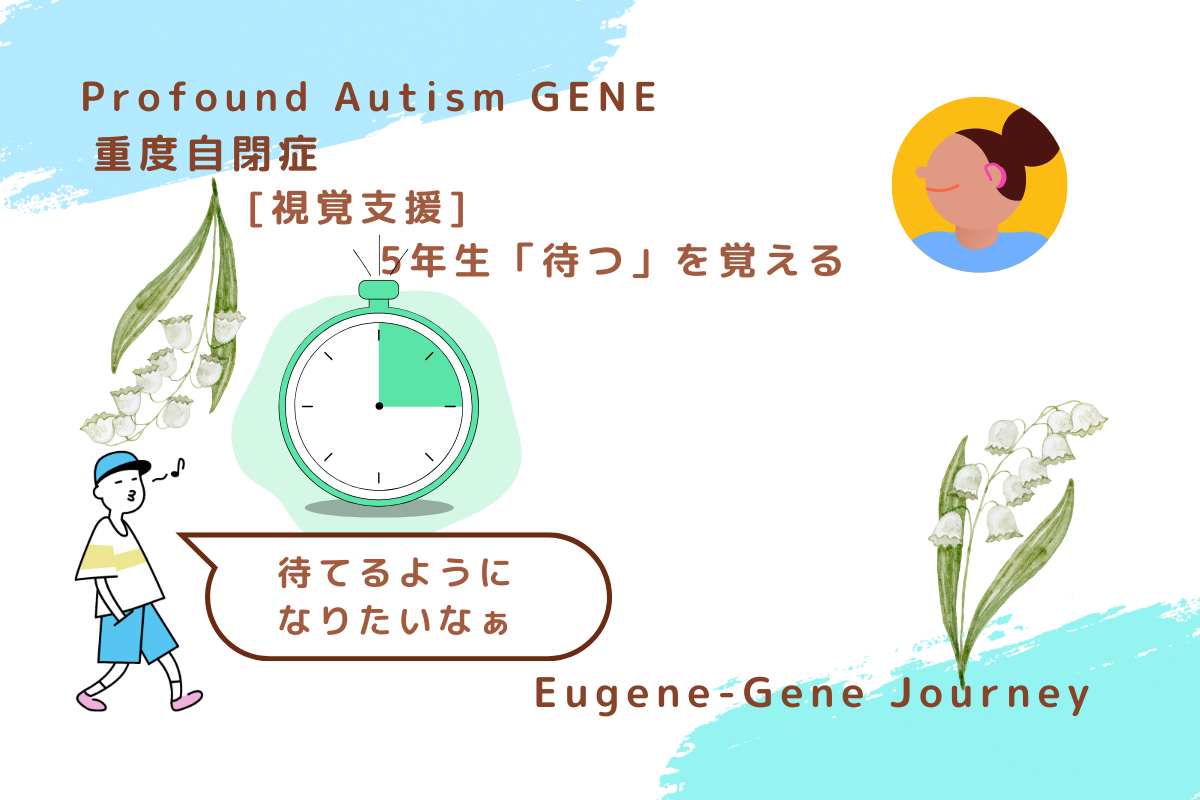5年生、自閉症の息子と取り組む新しい課題

5年生「待つ」を覚える
5年生になったGeneと、新しい先生たちと一緒に取り組むことになった課題。
それは――「待つ」ということ。
重度知的障害・自閉症にとって「待つ」は難しい
「待つ」ことは、これまでもずっと課題でした。
学校ではスケジュールを工夫して、できるだけ「待つ時間」を減らしてくれていましたが、それでも完全にゼロにはできません。
家族で外出したときも、「待つ」は大きな壁。
スケジュールカードを使っても、Geneにとっての「待つ」はきっと私たちとは感覚が違います。
おそらくGeneにとっての「待つ」は、たったの5秒。
「はい、待ちました。次は?」そんな感覚なのだと思います。
「時間の概念」との向き合い方
タイマーを使っても理解は簡単じゃない
学校や家庭ではタイムタイマーを使っています。
ですが、「赤い部分が減っていく=時間が減る」という概念をつかむのは難しい様子。
カルピスの量が少ないと「もっと!」と言えるGeneも、
タイマーの量や数字の減りはまだピンときていないようです。
数字の順番(1、2、3…)は覚えていますが、
「1はひとつ」「2はふたつ」という量の概念は、これからのチャレンジ。
音で区切るタイマーは理解できる
一方で、タイマーが鳴ると「終わり」と理解できるGene。
だからこそ、今はさまざまな方法を試しながら、彼に合う「時間の伝え方」を探しています。
「待つ」ができるようになると広がる世界
もし「待つ」が少しでもできるようになったら――。
- 「今準備するから、あと10分待ってね」
→「10分ね、待つよ」と落ち着ける。 - 外食や遊園地で
→「あと20分待てるかな?」と聞ける。 - 新幹線や飛行機の出発前
→「出発まで50分、一緒に待とうね」と話せる。
これまで、タイムタイマーや絵カード、時計などを使って伝えてきました。
けれど、理解が追いつかず、癇癪やパニックにつながってしまうことも多かったのです。
まとめ|今年の目標、「待つ」を育てて家族の笑顔を増やしたい
「早く次へ行きたい!」という気持ちが抑えきれず、怒ったり手が出たりしてしまう。
それはGeneの特性からくる自然なこと。
だけど、「待つ」を少しずつ練習できれば――家族みんなの行動範囲が広がり、もっとハッピーになれるはず。
今年は、「待つ」に本気で取り組む一年。
Geneと一緒に、小さなチャレンジを積み重ねていきたいと思います。
A New Challenge for Gene in 5th Grade
This year, as Gene entered 5th grade, we started working with his new teachers on a major challenge: learning to “wait.”
Why “waiting” is so difficult for a child with profound autism
Waiting has always been one of Gene’s biggest challenges.
At school, they carefully plan his schedule to minimize downtime—but waiting can’t be eliminated completely.
Even when we go out as a family, “waiting” is a struggle.
We use schedule cards, but to Gene, “waiting” might only mean five seconds.
“Yes, I waited… okay, next!” That’s probably how he feels.
Facing the concept of time
Why timers aren’t enough
We use visual timers like the Time Timer at home and school,
but the idea that the red section means time passing is hard to grasp.
Interestingly, Gene understands quantities when it comes to things like juice:
if his drink is low, he’ll ask for more! But numbers and amounts on timers don’t quite connect for him yet.
What works so far
He does understand that when a timer beeps, something ends.
So we keep trying different tools to help him connect the dots.
How mastering “waiting” can open up the world
If Gene can learn to wait, it would change so much:
- “I’m getting ready; can you wait 10 minutes?”
→ “Okay, I’ll wait.” - At a restaurant or amusement park:
→ “About 20 minutes—can you wait?” - At the airport or train station:
→ “We leave in 50 minutes. Let’s wait together.”
For now, without that understanding, frustration can quickly turn into meltdowns or aggression.
And that makes going out harder for all of us.
Our goal for this year — building patience, expanding freedom
Gene’s impatience comes from his own perspective and needs,
and it’s up to us to help him navigate that safely.
This year, we’re committed to practicing “waiting” together.
Step by step, we hope to expand our family’s world—and fill it with a little more calm and happiness.


